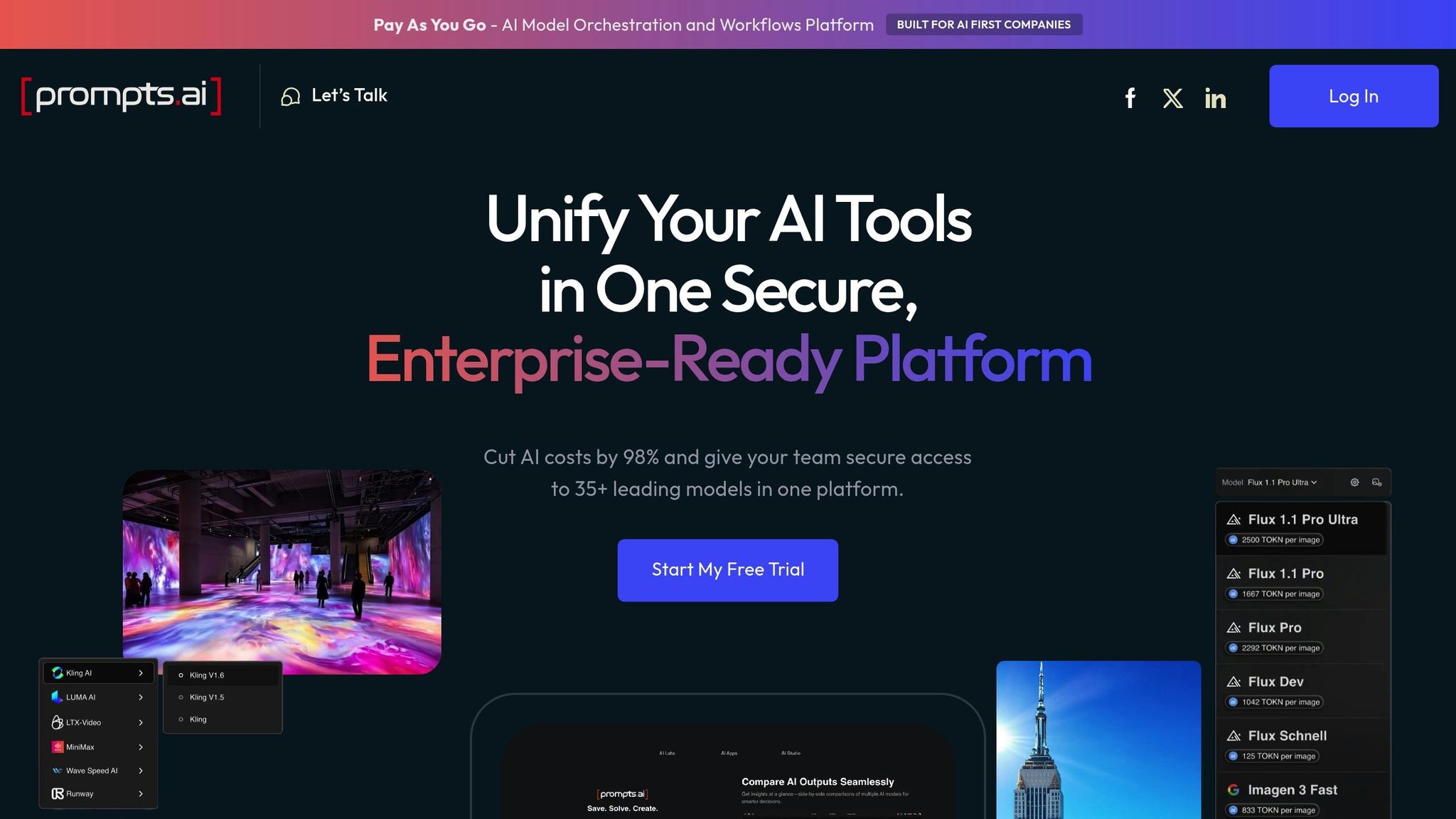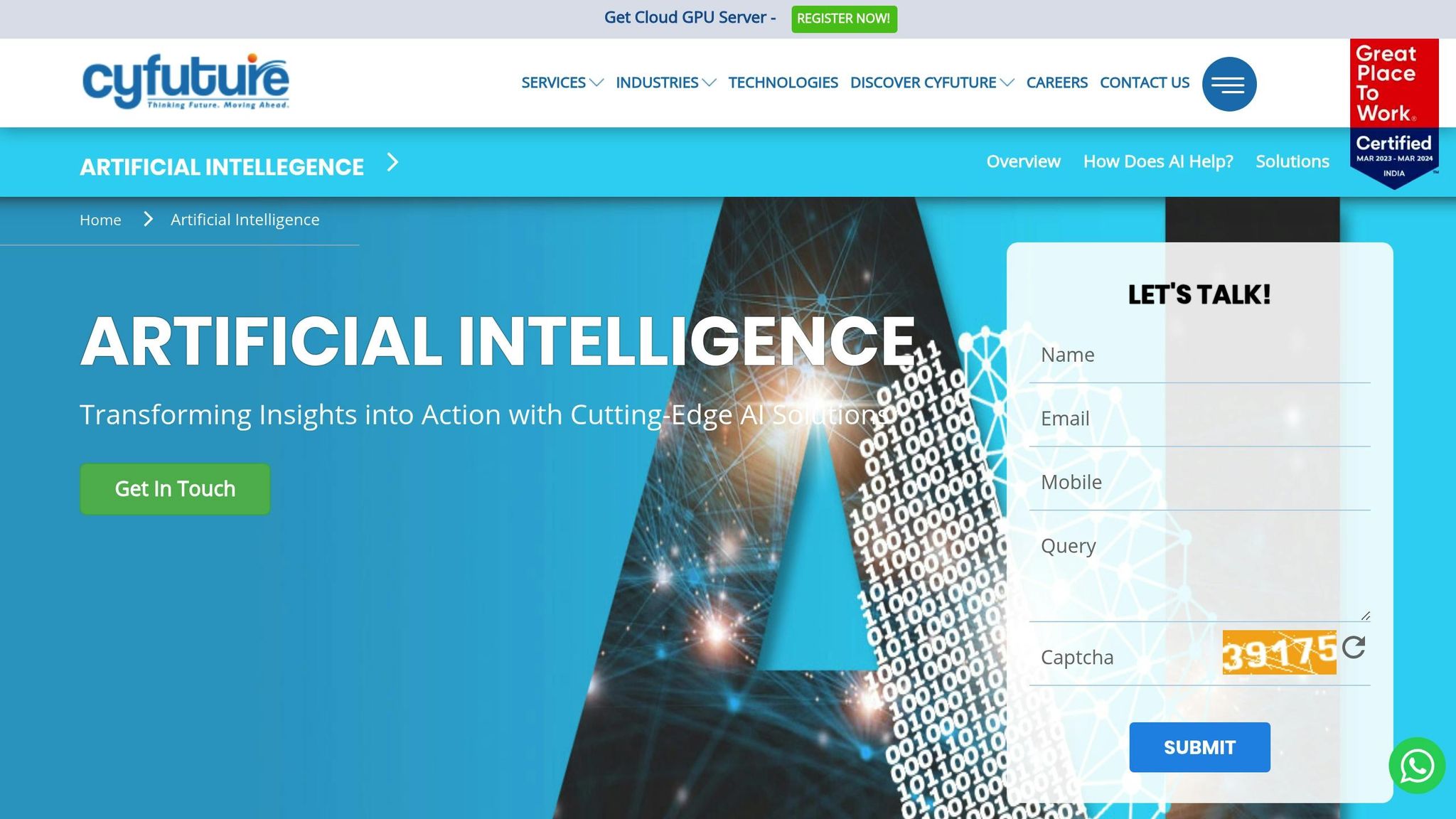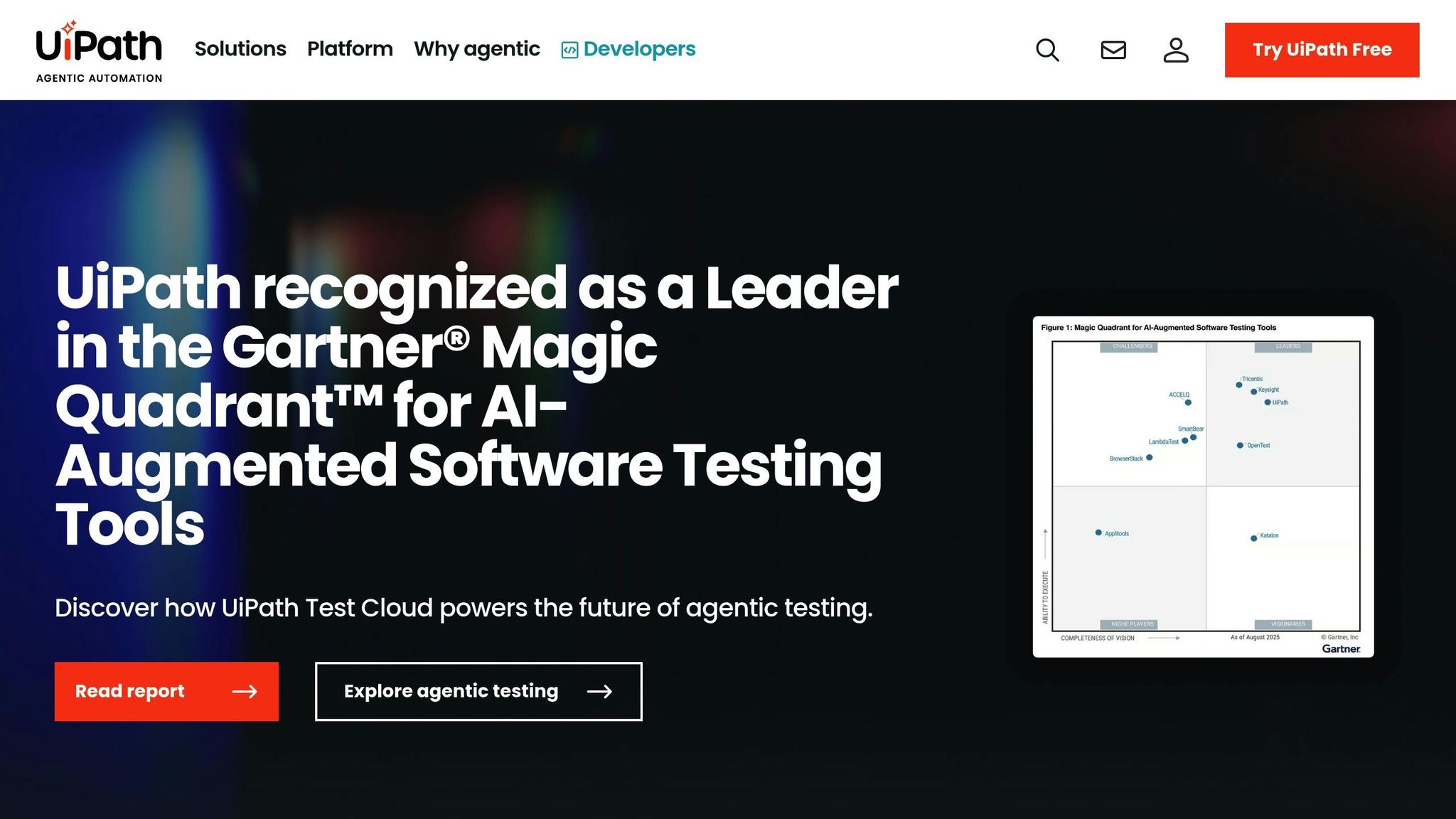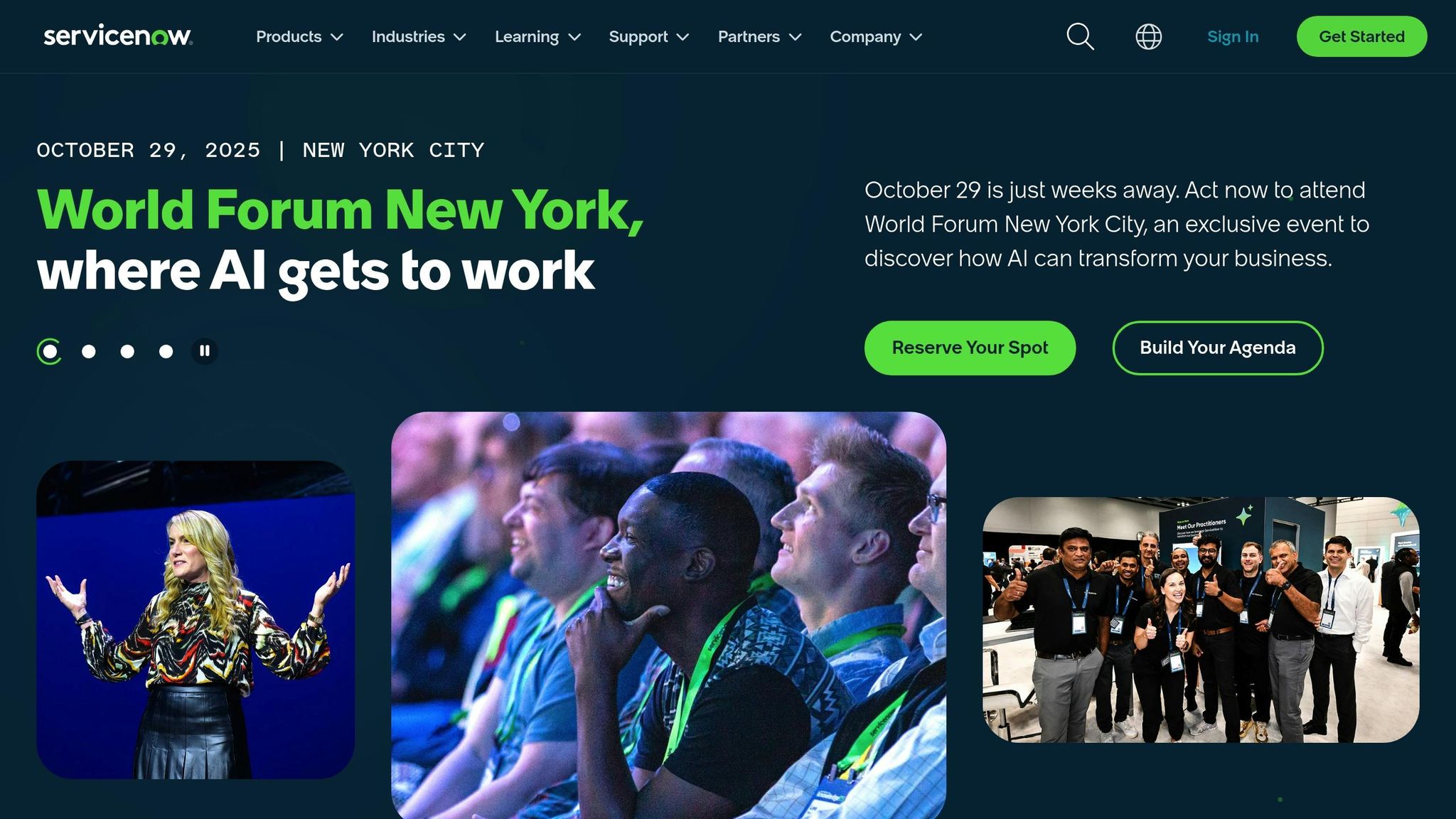
In 2026, managing AI workflows is critical for businesses aiming to cut costs, improve efficiency, and maintain security. Organizations are moving toward unified platforms that integrate multiple AI tools, reduce expenses, and simplify governance. This article evaluates six leading platforms for AI workflow orchestration, focusing on features like integration, cost management, security, and scalability.
| Platform | Key Features | Cost Management | Security & Compliance | Scalability | Best For |
|---|---|---|---|---|---|
| Prompts.ai | Unified access to 35+ AI models | Pay-as-you-go pricing | SOC 2, HIPAA, GDPR | High | AI model orchestration |
| Cyfuture AI | Cloud-native, flexible scaling | Usage-based pricing | End-to-end encryption | High | Cloud-first deployments |
| Zapier AI | No-code app connectors | Tiered pricing | Moderate security controls | Moderate | Non-technical automation |
| UiPath | AI-driven RPA | Licensing-based pricing | Comprehensive compliance | High | Process automation |
| Apache Airflow | Open-source, Python-based | No licensing fees | Community-supported | High | Technical workflow orchestration |
| ServiceNow | Enterprise automation tools | Subscription-based | Strong compliance | High | Large enterprise solutions |
Each platform offers unique strengths, catering to different needs like AI model management, process automation, or enterprise-grade workflows. Your choice should align with your organization’s goals, whether reducing AI costs, integrating tools, or scaling operations securely.

Prompts.ai brings together over 35 of the most advanced AI models into one secure, streamlined platform, redefining how organizations manage their AI workflows. By integrating leading large language models like GPT-5, Claude, LLaMA, and Gemini, the platform eliminates the hassle of juggling multiple AI tools.
Prompts.ai simplifies AI management by providing centralized access to more than 35 models through a single interface. This allows organizations to effortlessly switch between models such as GPT-5, Grok-4, and Claude, along with specialized tools like Flux Pro and Kling, without disrupting workflows.
But it doesn’t stop at unifying tools. The platform also enables side-by-side performance comparisons, so teams can identify the best model for specific tasks. To further boost efficiency, pre-built "Time Savers" are included, offering quick solutions that speed up implementation and deliver immediate results.
Prompts.ai stands out for its ability to dramatically cut AI costs - potentially by up to 98%. By consolidating tools and offering transparent, usage-based pricing through the TOKN credit system, the platform eliminates the need for multiple subscriptions. It employs a pay-as-you-go model that starts at $0/month for the basic plan, making it easy for organizations to explore AI tools without upfront investment. Business plans, priced between $99 and $129 per member per month, are designed to align with typical U.S. budgetary practices.
Another key feature is real-time cost tracking. With its built-in FinOps layer, Prompts.ai monitors token usage across all models, providing full visibility into AI spending. This transparency helps finance teams connect AI expenses directly to business outcomes and refine budgets based on actual performance data.
While cost efficiency is a major draw, Prompts.ai also prioritizes security. The platform is built on robust frameworks such as SOC 2 Type II, HIPAA, and GDPR to protect sensitive data. On June 19, 2025, it began its SOC 2 Type II audit process, reinforcing its dedication to stringent security standards. Users can monitor security in real time through a Trust Center, which provides access to policies, controls, and compliance updates. Continuous control monitoring is supported through a partnership with Vanta, ensuring security measures stay effective. For added governance, the platform includes comprehensive audit trails for all AI interactions, with compliance monitoring available across both Business and Personal plans.
Prompts.ai is designed to grow alongside your organization. Its architecture supports rapid expansion, allowing companies to add new models, users, and teams within minutes. The platform’s community-driven initiatives, such as the Prompt Engineer Certification program, help organizations build internal AI expertise and maintain best practices. Thanks to its user-friendly interface, new team members can get up to speed quickly, reducing onboarding time and associated costs. This seamless scalability ensures that Prompts.ai remains a valuable partner as businesses evolve and expand.

Cyfuture AI prioritizes robust security measures to ensure data protection at every stage. It uses end-to-end encryption to safeguard data both in transit and at rest. Access is tightly controlled through role-based access protocols, ensuring only authorized personnel can interact with specific models and datasets. Additionally, comprehensive audit logs are maintained to support regulatory compliance and provide a clear record of activities.

Zapier AI redefines workflow automation by linking thousands of applications through automated triggers. Its use of artificial intelligence simplifies repetitive tasks across various software platforms, making integrations possible without demanding extensive technical expertise. This extensive connectivity enables the platform to handle even the most intricate workflows with ease.
One of Zapier AI's standout features is its ability to connect different systems effortlessly, thanks to its vast library of app integrations. It bridges AI tools and traditional business applications seamlessly. For instance, users can pair GPT models with Google Sheets, connect Claude with Slack, or integrate AI-powered image generators with content management systems - all through intuitive drag-and-drop functionality.
The platform's AI-driven mapping feature speeds up setup by instantly suggesting field connections. Its multi-step workflows, called "Zaps", allow users to combine multiple AI services in a single sequence. For example, a single workflow could analyze customer feedback, categorize responses, craft personalized replies, and update CRM records automatically. Additionally, Zapier AI supports conditional logic and branching paths, enabling workflows to adapt based on AI insights or specific data characteristics.
Zapier AI employs a usage-based pricing structure that scales with automation needs, avoiding hefty upfront costs. Its Task History feature provides detailed analytics on automation usage, helping organizations pinpoint areas for cost savings and improve workflow efficiency.
The platform also includes an AI Task Optimizer, which evaluates workflow performance and suggests ways to streamline processes. By identifying redundant steps or proposing more efficient automation routes, organizations can often cut costs. Bulk operations further enhance cost-effectiveness by batching multiple items into single tasks, making high-volume activities like content creation or data analysis more affordable.
Designed for flexibility and efficiency, Zapier AI easily scales to meet the demands of high-volume operations. It automatically adjusts resources to handle numerous workflows simultaneously without compromising performance.
Collaboration tools enhance its appeal for larger organizations. Role-based permissions and shared workflow libraries ensure teams can maintain consistency across departments while still tailoring automations to their specific needs. Teams can also create reusable templates, track workflow performance metrics, and gain insights into automation adoption and effectiveness.
For enterprise users, the platform offers API access for custom integrations, enabling the creation of proprietary connectors or the extension of existing ones to meet unique requirements. Workflow versioning and rollback features add another layer of security, allowing teams to test new AI integrations in sandbox environments before deploying them. This minimizes disruptions to critical business operations while fostering innovation in automation design.

UiPath specializes in automating workflows through the power of AI, combining machine learning, document processing, and process mining. This platform empowers businesses to simplify intricate operations and improve efficiency.
UiPath stands out with its seamless integration capabilities. The AI Center allows businesses to embed AI models directly into their workflows, supporting both cloud-based and on-premises setups. It incorporates advanced tools like computer vision and natural language processing, while its Document Understanding feature works with external AI services to handle both structured and unstructured data. Additionally, its robust API integrations ensure smooth connectivity across a wide range of tools and platforms.
The platform offers flexible pricing models and uses process mining to uncover areas where automation can reduce costs. Features like unattended automation and built-in ROI analytics further enhance cost efficiency by optimizing resource allocation and operational spending.
UiPath places a strong emphasis on security, employing audit trails, advanced encryption for data both in transit and at rest, and secure credential management. Role-based access controls ensure that only authorized users can make changes or deploy workflows. Continuous monitoring adds an extra layer of protection, helping detect anomalies and ensuring adherence to industry regulations.
Designed to grow with your needs, UiPath’s architecture supports everything from small-scale implementations to large enterprise deployments. Features like load balancing, intelligent queue management, multi-tenant support, and version control make it easy to manage resources, streamline updates, and handle increasing demands efficiently.

Apache Airflow stands out as a powerful open-source platform designed for orchestrating workflows, including those used in AI and machine learning. Originally developed by Airbnb, Airflow uses directed acyclic graphs (DAGs) to define, schedule, and monitor workflows, making it an essential tool for data scientists and engineers working on complex AI pipelines.
Built on Python, the platform allows teams to program workflows programmatically, offering features like dynamic conditional logic, parallel processing, and handling intricate dependencies.
One of Apache Airflow's strengths is its ability to integrate seamlessly with a wide range of AI tools and services. Its ecosystem includes pre-built operators for major cloud platforms like AWS, Google Cloud Platform, and Microsoft Azure, as well as leading machine learning frameworks such as TensorFlow, PyTorch, and scikit-learn.
With its REST API, Airflow makes it easy to connect with external systems. Teams can also create custom operators to integrate proprietary tools or niche AI services. The platform’s support for triggering workflows based on events - such as file uploads, database updates, or API calls - makes it particularly effective for real-time AI operations.
Airflow’s connectivity extends to databases and data warehouses, including PostgreSQL, MySQL, MongoDB, Snowflake, and BigQuery. This broad compatibility ensures that AI workflows can access data from virtually any source without heavy reliance on data migration or transformation.
As an open-source platform, Apache Airflow eliminates licensing fees, allowing organizations to focus on managing computational resources efficiently. Its dynamic task allocation ensures resources are used only when needed, while task prioritization and resource pooling prevent unnecessary infrastructure scaling.
Organizations can further reduce costs by scheduling resource-intensive tasks, like AI training jobs, during off-peak hours when cloud computing rates are typically lower. Airflow’s monitoring tools provide insights into resource usage, helping teams identify inefficiencies and fine-tune workflows for better cost management. Additionally, integration with cloud auto-scaling systems ensures infrastructure adapts to actual workload demands, avoiding overprovisioning.
Apache Airflow includes robust security features to protect sensitive AI workflows and data. With role-based access control (RBAC), administrators can assign specific permissions to user groups, ensuring only authorized personnel have access to critical models and workflows.
The platform encrypts connections to secure data in transit and integrates with enterprise authentication systems like LDAP and OAuth for centralized user management. Audit logs track workflow executions, modifications, and access attempts, supporting compliance with regulatory requirements.
To further safeguard sensitive information, Airflow encrypts API keys and database credentials in its connection store. It also supports integration with external secret management systems, adding an extra layer of security for handling critical authentication details.

ServiceNow has grown into a robust enterprise automation platform, offering advanced AI-driven workflow capabilities. By consolidating AI tools within a single system, it ensures smoother workflow management while upholding enterprise-level security and governance. At the heart of this platform is the Now Platform, which powers automation to simplify complex business operations.
With tools like AI Search and Now Assist, ServiceNow creates workflows that can automatically assign tasks, predict outcomes, and optimize resource use. Its no-code/low-code development approach makes it easy for business users to design AI workflows without needing deep technical skills.
ServiceNow excels in integrating AI workflows with existing enterprise systems. Its Flow Designer and App Engine, combined with IntegrationHub, provide seamless connections to external applications using pre-built connectors. REST APIs and GraphQL support further enhance integration, enabling connections with cloud-based machine learning services from providers like AWS, Microsoft Azure, and Google Cloud.
Flow Designer allows teams to craft intricate workflows spanning multiple systems without writing any code. Certified connectors make it easy to link ServiceNow with tools like data warehouses, CRM platforms, and business intelligence software. For on-premises systems, MID Server technology ensures secure connections while adhering to data sovereignty requirements.
The App Engine offers a space to develop and deploy custom AI applications directly within the platform. This ensures workflows align with existing business processes and governance standards, creating a cohesive and secure environment for automation.
ServiceNow’s subscription-based pricing model helps organizations predict and manage workflow costs effectively. Performance Analytics tracks resource use and workflow efficiency, helping teams identify areas where costs can be reduced.
The platform’s automated resource allocation ensures efficient distribution of resources across workflows. Predictive Intelligence plays a key role in forecasting resource needs, helping organizations optimize infrastructure spending by analyzing patterns in workflow execution.
The IT Operations Management module adds another layer of cost control by monitoring the financial impact of workflows. Features like budget alerts and approval workflows for resource-heavy processes help keep spending within acceptable limits.
ServiceNow prioritizes security with certifications like SOC 2 Type II, ISO 27001, and FedRAMP. Its zero-trust architecture includes multi-factor authentication, role-based access controls, and continuous security monitoring to protect sensitive workflows.
Data is encrypted both in transit and at rest, with support for customer-managed encryption keys. The Security Operations module offers threat detection to monitor workflows for unusual activity or potential breaches.
For regulatory compliance, the Governance, Risk, and Compliance (GRC) suite provides tools like audit trails, policy enforcement, and automated reporting. These features help organizations meet standards like GDPR, HIPAA, and SOX with ease.
ServiceNow’s multi-tenant cloud architecture ensures seamless scalability to meet growing workflow demands. Elastic computing capabilities allow the platform to handle workloads of various sizes, from small departmental tasks to enterprise-wide initiatives.
Load balancing and auto-scaling distribute workflows across servers, preventing performance issues during peak times. Horizontal scaling ensures additional processing power can be added as requirements grow.
The platform also supports separate environments for development, testing, and production workflows. This separation enables scaling and experimentation without disrupting critical business operations, providing both flexibility and reliability.
This comparison highlights the importance of unified AI orchestration, as discussed earlier, and aims to guide organizations in selecting a platform that aligns with their operational needs and budgetary considerations.
Prompts.ai offers streamlined access to over 35 leading AI models through a single, secure interface. Its pay-as-you-go TOKN system can reduce costs by as much as 98%, while real-time FinOps ensures transparent usage tracking. However, organizations looking for broader workflow automation may need to supplement it with additional tools.
Cyfuture AI is designed with a cloud-native approach, allowing it to scale effectively for diverse workload demands, from small experiments to large enterprise projects. However, its cloud-based pricing model can pose challenges for organizations with fluctuating usage patterns, making cost predictability harder to achieve.
Zapier AI focuses on no-code workflow automation, offering an extensive library of pre-built connectors. This makes it particularly appealing to non-technical teams. However, for enterprises requiring advanced orchestration or rigorous governance, its capabilities might feel limited.
UiPath specializes in robust robotic process automation (RPA) with embedded AI features, excelling at automating structured, repetitive tasks. Its strong compliance and audit trails are particularly beneficial for industries with strict regulations, though the platform’s steeper learning curve may require more time and resources to master.
Apache Airflow is an open-source solution that provides technical teams with significant flexibility for managing workflows through code. It supports detailed scheduling and monitoring of multi-step AI pipelines without licensing fees. However, leveraging its full potential requires a high level of technical expertise and active management of infrastructure.
ServiceNow delivers extensive enterprise automation capabilities, combining strong governance, security, and scalability. It is ideal for integrating AI workflows into broader business processes. However, its complexity and cost structure may make it less accessible for smaller organizations.
The table below summarizes key features and suitability for quick reference:
| Platform | Key Integration Features | Cost Optimization | Security & Compliance | Scalability | Best Suited For |
|---|---|---|---|---|---|
| Prompts.ai | Unified access to 35+ AI models | Pay-as-you-go | SOC 2, HIPAA, GDPR | High | AI model orchestration |
| Cyfuture AI | Cloud-native | Usage-based | Solid security | High | Cloud-first deployments |
| Zapier AI | Pre-built connectors | Tiered pricing | Moderate controls | Moderate | No-code automation |
| UiPath | End-to-end automation with AI | Licensing-based | Comprehensive compliance | High | Process automation |
| Apache Airflow | Open-source, code-based | Free | Community-supported | High | Technical orchestration |
| ServiceNow | Enterprise automation | Subscription | Strong compliance | High | Large enterprises |
Selecting the right platform depends on matching its strengths to your organization's priorities. For centralized AI model management and cost efficiency, Prompts.ai stands out. On the other hand, businesses with broader process automation needs may benefit from the specialized features offered by other platforms.
As we look at the AI workflow orchestration landscape in 2026, it’s clear that different platforms are tailored to meet distinct operational needs. Prompts.ai emerges as a strong contender for enterprises prioritizing AI model management, offering unified access to models, substantial cost savings, and advanced security measures. Its focus on cost control and centralized management makes it a compelling choice for organizations seeking streamlined AI orchestration.
That said, other platforms bring their own strengths to the table, particularly in areas like regulated industries, technical orchestration, user-friendly automation, and large-scale enterprise solutions. These options may better suit businesses with broader automation goals beyond AI model management.
Looking ahead, the future of AI workflow orchestration will likely involve deeper multimodal integration, real-time cost tracking, and enhanced governance frameworks. These advancements will continue to shape platforms, equipping them to support emerging models and capabilities. U.S.-based enterprises, in particular, should prepare for tools that adapt to these evolving demands.
Ultimately, the best platform for your organization depends on your specific needs. If consolidating AI model usage and maintaining transparent cost control are top priorities, Prompts.ai provides a unified approach that delivers measurable savings. However, for those focused on broader process automation, exploring the specialized features of alternative platforms may be the better path.
The key to success lies in aligning platform capabilities with both your current and future operational goals, ensuring scalability, security, and governance as AI adoption continues to expand across industries in the United States.
When evaluating a platform to manage AI workflows in 2026, there are several important factors to keep in mind to ensure it aligns with your needs. Start by assessing integration capabilities. The platform should seamlessly connect with your existing tools, such as ERP or CRM systems, and offer robust API support to streamline your operations.
Next, think about scalability. A good platform can handle increasing workloads and a growing number of users while maintaining optimal performance.
Examine the platform's AI features as well. Look for support in areas like Natural Language Processing (NLP) and predictive analytics, which can drive automation and provide deeper insights into your data.
Don't overlook security - it’s crucial. Features like role-based access controls, encryption, and compliance tools should be in place to protect sensitive information.
Lastly, prioritize ease of use. Platforms with intuitive interfaces, no-code or low-code options, and pre-built templates can help your team hit the ground running without a steep learning curve.
Prompts.ai empowers organizations to manage expenses effectively through its integrated FinOps layer, which provides real-time insights into usage, spending, and return on investment (ROI). This feature ensures that every interaction is both cost-effective and transparent.
With its pay-as-you-go pricing model powered by TOKN credits, users only pay for what they use. By removing recurring fees, Prompts.ai offers businesses the flexibility to scale their operations seamlessly, making it a practical choice for companies of any size.
Prompts.ai takes data security seriously, employing advanced measures to protect sensitive information and ensure compliance with industry regulations. These measures include encryption protocols that secure data both at rest and during transit, regular security audits to identify and address vulnerabilities, and strict access controls to prevent unauthorized access.
The platform also aligns with major compliance frameworks, including GDPR, CCPA, and other relevant regulations. By consistently monitoring and refining its security practices, Prompts.ai delivers a trustworthy and secure environment for managing AI workflows.


